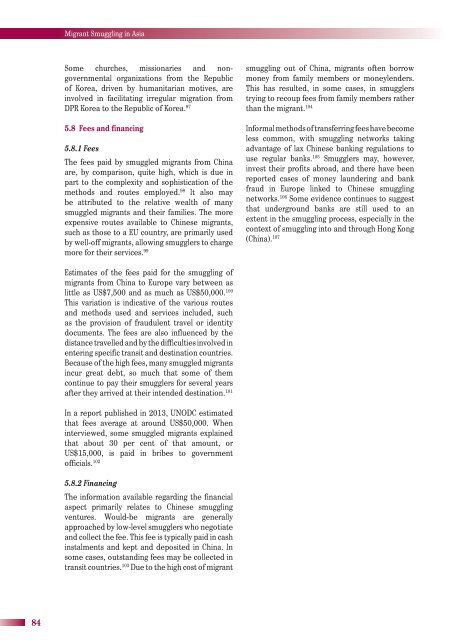Current_Trends_and_Related_Challenges_web
Current_Trends_and_Related_Challenges_web
Current_Trends_and_Related_Challenges_web
You also want an ePaper? Increase the reach of your titles
YUMPU automatically turns print PDFs into web optimized ePapers that Google loves.
Migrant Smuggling in Asia<br />
Some churches, missionaries <strong>and</strong> nongovernmental<br />
organizations from the Republic<br />
of Korea, driven by humanitarian motives, are<br />
involved in facilitating irregular migration from<br />
DPR Korea to the Republic of Korea. 97<br />
5.8 Fees <strong>and</strong> financing<br />
5.8.1 Fees<br />
The fees paid by smuggled migrants from China<br />
are, by comparison, quite high, which is due in<br />
part to the complexity <strong>and</strong> sophistication of the<br />
methods <strong>and</strong> routes employed. 98 It also may<br />
be attributed to the relative wealth of many<br />
smuggled migrants <strong>and</strong> their families. The more<br />
expensive routes available to Chinese migrants,<br />
such as those to a EU country, are primarily used<br />
by well-off migrants, allowing smugglers to charge<br />
more for their services. 99<br />
smuggling out of China, migrants often borrow<br />
money from family members or moneylenders.<br />
This has resulted, in some cases, in smugglers<br />
trying to recoup fees from family members rather<br />
than the migrant. 104<br />
Informal methods of transferring fees have become<br />
less common, with smuggling networks taking<br />
advantage of lax Chinese banking regulations to<br />
use regular banks. 105 Smugglers may, however,<br />
invest their profits abroad, <strong>and</strong> there have been<br />
reported cases of money laundering <strong>and</strong> bank<br />
fraud in Europe linked to Chinese smuggling<br />
networks. 106 Some evidence continues to suggest<br />
that underground banks are still used to an<br />
extent in the smuggling process, especially in the<br />
context of smuggling into <strong>and</strong> through Hong Kong<br />
(China). 107<br />
Estimates of the fees paid for the smuggling of<br />
migrants from China to Europe vary between as<br />
little as US$7,500 <strong>and</strong> as much as US$50,000. 100<br />
This variation is indicative of the various routes<br />
<strong>and</strong> methods used <strong>and</strong> services included, such<br />
as the provision of fraudulent travel or identity<br />
documents. The fees are also influenced by the<br />
distance travelled <strong>and</strong> by the difficulties involved in<br />
entering specific transit <strong>and</strong> destination countries.<br />
Because of the high fees, many smuggled migrants<br />
incur great debt, so much that some of them<br />
continue to pay their smugglers for several years<br />
after they arrived at their intended destination. 101<br />
In a report published in 2013, UNODC estimated<br />
that fees average at around US$50,000. When<br />
interviewed, some smuggled migrants explained<br />
that about 30 per cent of that amount, or<br />
US$15,000, is paid in bribes to government<br />
officials. 102<br />
5.8.2 Financing<br />
The information available regarding the financial<br />
aspect primarily relates to Chinese smuggling<br />
ventures. Would-be migrants are generally<br />
approached by low-level smugglers who negotiate<br />
<strong>and</strong> collect the fee. This fee is typically paid in cash<br />
instalments <strong>and</strong> kept <strong>and</strong> deposited in China. In<br />
some cases, outst<strong>and</strong>ing fees may be collected in<br />
transit countries. 103 Due to the high cost of migrant<br />
84


